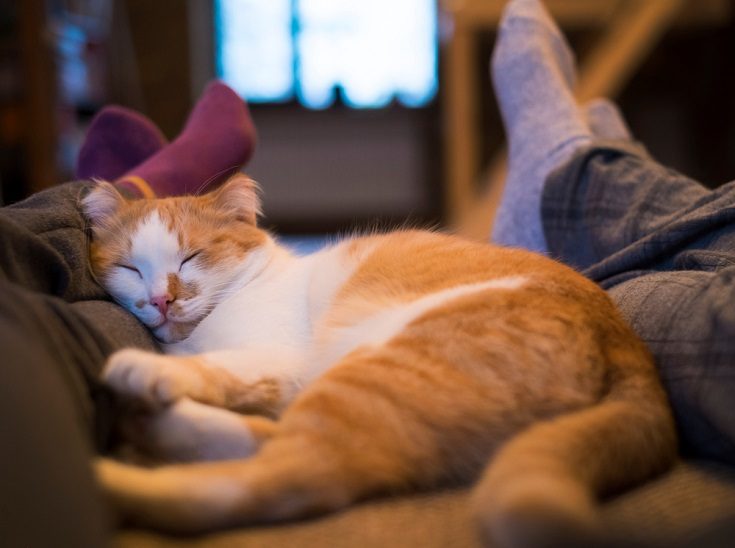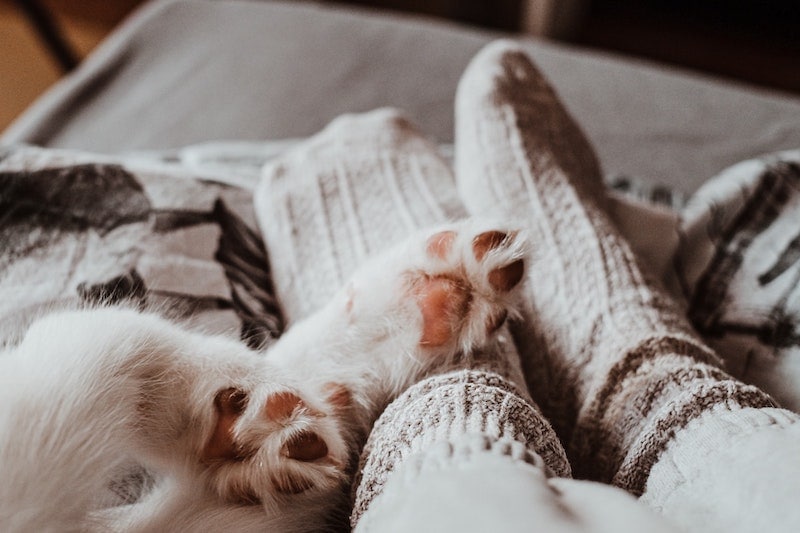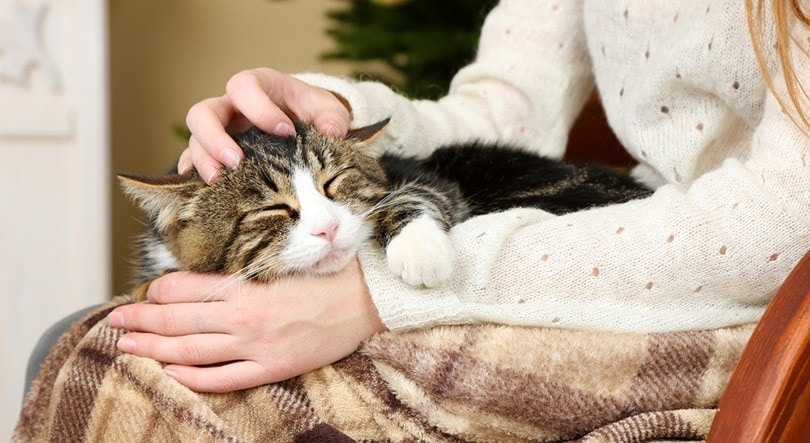
As cat owners, we all know that our feline friends love to sleep. In fact, they can sleep up to 16 hours a day, believe it or not. Cats are also known for sleeping in some pretty weird places. Some of us even have cats that sleep at their feet. But have you ever wondered why your feet are your cat’s preferred sleeping spot?
Is it because they love your company or is there more to it? Understanding your cat’s sleeping habits can reveal a lot about their personality and their relationship with you. In this article, we’ll be decoding your feline’s sleeping preferences and uncovering the reasons why they love to curl up at your feet.
The 6 Reasons Why Your Cat is Sleeping at Your Feet
1. They Want to Be Close To Their Owners
Cat owners will confirm that cats are wonderful creatures. Do not let their shyness fool you. Cats want to be close to their owners in a unique way.
Sleeping with you is one of their favorite ways to show their affection. Your cat will do this to express their love for you. Your cat will also feel at ease when they hear your heartbeat or your breathing.
This behavior can be compared to how cats behave in the wild, where they show affection to their family members. They bond by grooming each other and by pillowing together while they sleep.

2. It is Familiar to Them
Cats are creatures of habit and routine. If your cat has been sleeping at your feet for a while, they’ve likely developed a routine and feel comfortable in that spot. Cats are creatures of comfort and like to stick to what they know. So, while it may have started as a way to be close to you at night, it may be simply the most familiar option at the moment.
3. It Makes Them Feel Safe
Even when cats sleep their natural animal instincts are always on, as in the wild they’d need them to survive. But cats are also naturally hunters and seek out places where they can recharge their batteries between hunts. You’re their safe place in the home. This behavior indicates that cats are more vulnerable while they sleep, and it suggests that they trust you.
This behavior can be traced back as far as kittenhood when the mothers and litters would sleep on one another. As they grow up, they acquire social skills and other skills which they carry with them into adulthood.

4. They Love Your Body Heat
Cats like to be warm and cozy when they sleep, and the area around their owner’s feet is often the warmest part of the bed. The human body gives off heat, and cats are naturally drawn to this warmth.
Why do cats lie on you? Your body is warmer than any other spot in the room, so cats love to lay on you. Warmth induces better sleep quality in cats, so it’s a good idea to keep them warm while they sleep on you.
5. They Want to Protect You
Another reason why cats like to sleep at their owner’s feet is protection. Cats are instinctively aware of their surroundings, and they like to be able to see what’s going on around them. When they sleep at their owner’s feet, they are able to keep an eye on their surroundings and protect their owner if necessary.

6. They’re Simply Marking Their Territory
Like many animals in the wild, in their natural environment, cats are territorial. To claim their territory, cats release pheromones from their scent glands. They’re sort of marking your territory by sleeping on top of you. This is actually a compliment. It’s a way for them to say you are part of their social group. This is similar to the way wild cats mark other cats belonging to the same group. This is how your cat will mark their scent by rubbing their heads on you or their bodies when they sleep at your feet.
The Benefits of Sleeping with Your Cat
Sleeping with a cat can have several benefits for both the cat and the owner. For the cat, sleeping with their owner can help to reduce stress and anxiety. This is because they feel safe and secure when they’re close to their owner. Sleeping with their owner can also help to regulate their sleep patterns, which can improve their overall health and well-being.
For the owner, sleeping with a cat can be a great way to reduce stress and anxiety. Cats have a calming effect on humans, and their purring can be very soothing. Sleeping with a cat can also help to improve the quality of sleep, as the warmth and comfort of the cat can help to promote relaxation.

Types of Cat Personalities and Sleeping Habits
Just like humans, cats have different personalities and sleeping habits. Some cats are more social than others and prefer to sleep close to their owner, while others are more independent and prefer to sleep on their own. Understanding your cat’s personality and sleeping habits can help you to create a comfortable sleeping environment for them.
For example, if you have a social cat that likes to sleep close to you, you may want to invest in a larger bed to give them more space. You may also want to consider using a cat bed or blanket to provide them with extra warmth and comfort. On the other hand, if you have an independent cat that prefers to sleep on their own, you may want to provide them with a separate sleeping area.
Understanding Your Cat’s Sleeping Patterns
Understanding your cat’s sleeping patterns is important if you want to create a comfortable sleeping environment for them. Cats sleep for about 16 hours a day, but they don’t sleep for long periods of time like humans. Instead, they take short naps (enter the term “cat nap”) throughout the day and night.
Cats are also super light sleepers, and they’re easily disturbed by noise and movement. This is why it’s essential to create a quiet and peaceful sleeping environment for them.
Lastly, cats have a unique sleep cycle that includes both light and deep sleep. During light sleep, cats are easily disturbed and can wake up at the slightest noise or movement. However, during deep sleep, cats are completely relaxed and can be difficult to wake up. It’s during this phase of sleep that cats will often dream and twitch their whiskers, paws, and tails.
Considering that the average cat spends about 3/4 of the day sleeping, providing them with a comfortable bed is very important. The Hepper Nest Bed is our favorite choice thanks to its innovative and cat-tailored design. It features a wide lip for resting tired heads, a rounded bowl shape for maximum support, and a warm fleece liner to keep them cozy. Provide your kitty with the perfect lounger and bed by clicking here.
At Pet Keen, we’ve admired Hepper for many years and decided to take a controlling ownership interest so that we could benefit from the outstanding designs of this cool cat company!
The Meaning Behind Your Cat’s Sleeping Position
Now that we know why cats prefer to sleep at their owner’s feet, let’s explore the meaning behind your cat’s sleeping position. The position your cat sleeps in can reveal a lot about their personality and how they’re feeling.
If your cat sleeps curled up in a ball, it means they feel safe and secure. This is a common sleeping position for cats who are content and happy in their environment. If your cat sleeps on their back with their paws in the air, it means they feel completely relaxed and comfortable. This is a sign that your cat trusts you and feels safe in your presence.
If your cat sleeps with their head tucked in, it means they’re feeling stressed or anxious. This could be a sign that your cat is not feeling well or is experiencing some kind of discomfort. If your cat is sleeping in an unusual position, it’s always a good idea to monitor their behavior and contact your veterinarian if you notice any changes to make sure they’re not experiencing any health issues.

Tips for a Better Sleep with Your Cat
If you want to create a comfortable sleeping environment for your cat and get a better night’s sleep yourself, there are several things you can do:
- Invest in a larger bed to give your cat more space.
- Use a cat bed or blanket to provide extra warmth and comfort.
- Keep a routine
- Allow some night playtime if your cat is expecting it before their sleeping time
- Provide your cat with a separate sleeping area if they prefer to sleep on their own.
Wrapping Things Up
Cats are fascinating animals, and their sleeping habits are just one of the many things that make them unique. Sleeping with a cat can have several benefits for both the cat and the owner, including reduced stress and anxiety and improved sleep quality. Your cat is likely sleeping at your feet because it simply craves your warmth, protection, and familiarity. So, the next time your cat snuggles up to your feet while you sleep, remember that it’s a sign of their trust and affection.
Featured Image Credit: tache, Shutterstock









